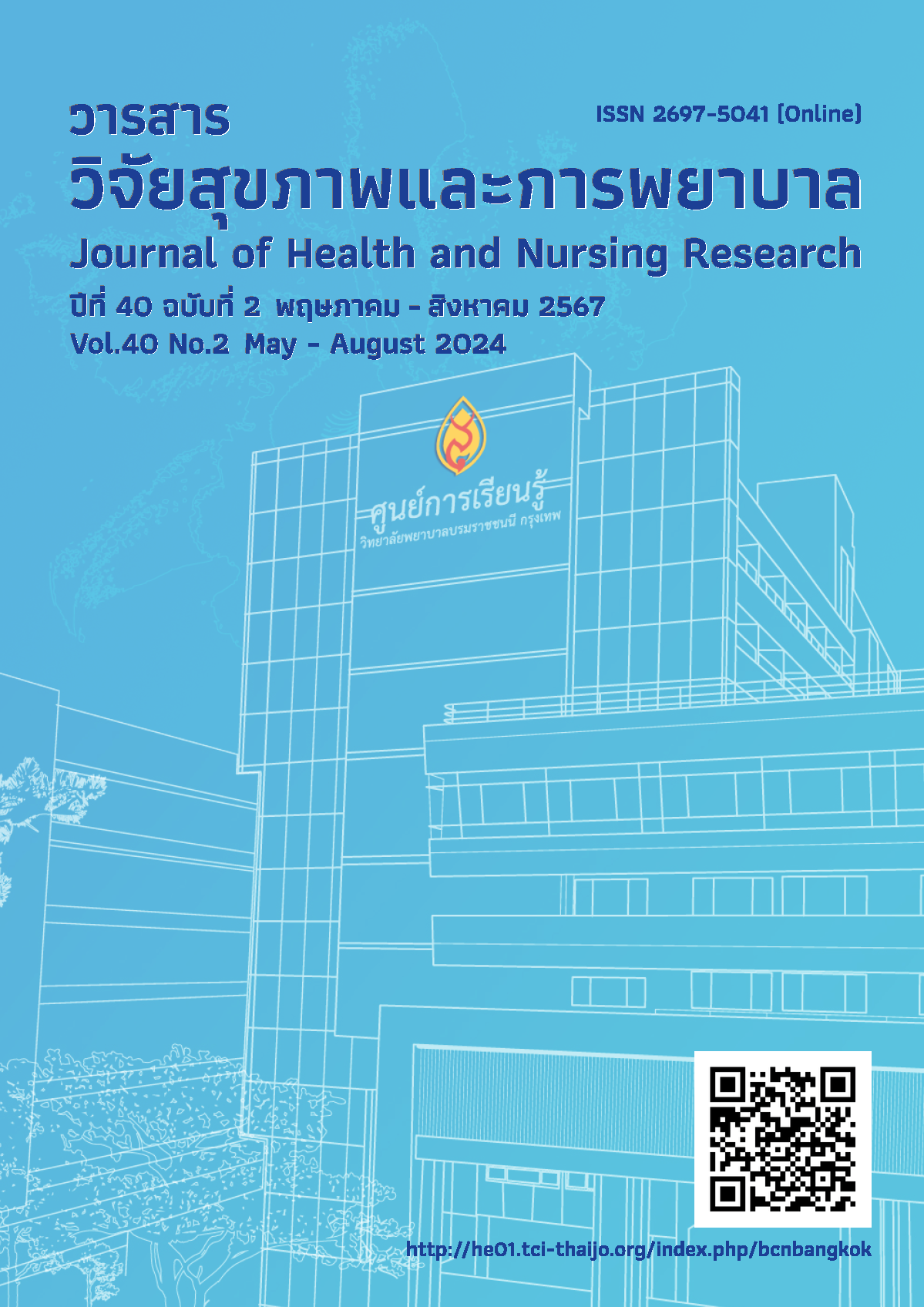การพัฒนารูปแบบการวางแผนจำหน่ายผู้ป่วยรับการผ่าตัดกระดูกสันหลัง
คำสำคัญ:
การพัฒนา , รูปแบบการวางแผนจำหน่าย , ผู้ป่วยรับการผ่าตัดกระดูกสันหลังบทคัดย่อ
บทนำ: ผู้ป่วยที่ได้รับการผ่าตัดกระดูกสันหลังมีโอกาสที่แผลจะติดเชื้อหลังการผ่าตัดและมีภาวะแทรกซ้อนอื่น ๆ ซึ่งจำเป็นต้องได้รับการวางแผนจำหน่ายที่จะช่วยเพิ่มความสามารถในการดูแลตนเอง
วัตถุประสงค์การวิจัย: เพื่อพัฒนาและศึกษาประสิทธิผลของรูปแบบการวางแผนจำหน่ายผู้ป่วยรับการผ่าตัดกระดูกสันหลัง
ระเบียบวิธีวิจัย: การวิจัยและพัฒนาโดยกลุ่มตัวอย่างประกอบด้วย 1) พยาบาลวิชาชีพจำนวน 8 คน และ 2) ผู้ป่วยรับการผ่าตัดกระดูกสันหลังแบ่งเป็นกลุ่มทดลองและกลุ่มเปรียบเทียบ กลุ่มละ 25 คน รวม 50 คน เครื่องมือที่ใช้ในการวิจัย ได้แก่ 1) แนวคำถามการสนทนากลุ่ม 2) รูปแบบการวางแผนจำหน่ายผู้ป่วยรับการผ่าตัดกระดูกสันหลัง 3) แบบสอบถามพฤติกรรมการดูแลตนเองของผู้ป่วย และ 4) แบบสอบถามความพึงพอใจของผู้ป่วย วิเคราะห์ข้อมูลโดยใช้สถิติเชิงพรรณนา และ Independent t - test
ผลการวิจัย: รูปแบบการวางแผนจำหน่ายประกอบด้วย 5 ขั้นตอน คือ การประเมินปัญหาและความต้องการของผู้ป่วยและผู้ดูแล การวินิจฉัยทางการพยาบาล การวางแผนจำหน่าย การปฏิบัติตามแผน และการประเมินผลการพยาบาล หลังการพัฒนารูปแบบพบว่าผู้ป่วยรับการผ่าตัดกระดูกสันหลัง มีพฤติกรรมการดูแลตนเองและความพึงพอใจสูงกว่าผู้ป่วยที่ได้รับการวางแผนจำหน่ายตามปกติอย่างมีนัยสำคัญทางสถิติที่ระดับ .05 และไม่มีผู้ป่วยกลับมารักษาซ้ำในโรงพยาบาล
สรุปผล: รูปแบบการวางแผนจำหน่ายผู้ป่วยรับการผ่าตัดกระดูกสันหลังสามารถช่วยส่งเสริมพฤติกรรมการดูแลตนเองและความพึงพอใจของผู้ป่วยรับการผ่าตัดกระดูกสันหลัง และยังช่วยลดการมารักษาซ้ำในโรงพยาบาล
ข้อเสนอแนะ: ผลการวิจัยครั้งนี้สามารถนำไปใช้เป็นข้อมูลพื้นฐานในการวางแผนจำหน่ายผู้ป่วยกลุ่มอื่นที่เกี่ยวข้องโดยจะต้องพิจารณาให้เหมาะสมกับผู้ป่วยที่มีปัญหาและความต้องการเฉพาะ ที่อาจแตกต่างจากผู้ป่วยรับการผ่าตัดกระดูกสันหลัง
Downloads
เอกสารอ้างอิง
Ministry of Public Health. Cause of morbidity by region per 1,000 population. 2017 Available from: http://www.pcko.moph.go.th/Health-Statistics/stratistics60.pdf
Karnget N. Nursing of spine surgery patients: Case studies. 6th National Conference Nakhon Ratchasima College; 2019. (in Thai)
Santiworabutr S. Effects of self-efficacy promotion program on the quality of recovery after surgery and the daily routine of postoperative patient’s Lumbar spine surgery [dissertation]. Bangkok: Christian University; 2018. (in Thai)
Fatoye F, Gebrye T, Odeyemi I. Real-world incidence and prevalence of low back pain using routinely collected data. Rheumatol Int 2019;39(2):619-26.
Stevans JM, Delitto A, Khoja SS, Patterson CG, Smith CN, Schneider MJ, et al. Risk factors associated with transition from acute to chronic low back pain in US patients seeking primary care. JAMA Netw Open 2021;4(2):e2037371.
Yoyuenyong C, Srimongkot P. Factors predicting the recovery of activity of daily living function in patients undergoing lumbar surgery. Journal of the Royal Thai Army Nurses 2015;16(1):62-9. (in Thai)
Taeviriyakul C, Cheevakasemsook A, Pinyopasaku W. The development of a discharge planning model for elderly patients with Pneumonia at Central Chest Institute of Thailand. Thai Journal of Nursing 2020;69(3):35-43. (in Thai)
Wiangnon S. Development of a discharge planning with empowerment enhancement model for elderly patients with Pneumonia, Thung Khao Luang hospital. Journal of Research and Health Innovative Development 2024;5(1):328-41. (in Thai)
The Healthcare Accreditation Institute (Public Organization). Hospital and healthcare standards 4th Ed. Nonthaburi: The Healthcare Accreditation Institute (Public Organization), 2018. (in Thai)
Thabo Crown Prince Hospital. Statistics of patients admitted to hospital report; 2023. (in Thai)
McKeehan KM, Coulton CJ. A system approach to program development for continuity of care in hospitals. In: McClelland, KM, Kelly K, Buckwalter K, editors. Continuity of care: Advancing the concept of discharge planning. Florida: Grune & Stratton; 1985. p. 79-92.
Nursing Division, Office of the Permanent Secretary, Ministry of Public Health. Distribution planning guidelines. Patients, Nursing Division. Bangkok: Thammasat University Printing House. 1996. (in Thai)
Sanitlou N, Sartphet W, Naphaarrak Y. Sample size calculation using G*Power program. Journal of Suvarnabhumi Institute of Technology 2019;5(1):496-506. (in Thai)
Cohen J. Statistical power analysis for the behavioral sciences.2nd ed. New Jersey: Lawrence Erlbaum Associates, Publishers; 1988.
Lemeshow S, David W, Hosmer Jr, Jannelle K, Lwanga SK. Adequacy of sample size in health studies. New York: John Wiley & Sons; 1990.
Wong EL, Yam CH, Cheung AW, Leung MC, Chan FW, Wong FY, et al. Barriers to effective discharge planning: A qualitative study investigating the perspectives of frontline healthcare professionals. BioMed Central Health Services Research 2011;11(1):1-10.
Chairin B, Akkadechanunt T, Sirakamon S. Quality improvement of discharge planning for patients with acute myocardial infarction in cardiac care unit, Nakornping Hospital, Chiang Mai Province. Nursing Journal 2020;47(3):389-99. (in Thai)
Thiwong P, Cheevakasemsook A, Pinyopasakul W. The development of a discharge planning model for pediatric patients with Athma at Sunpasitthiprasong Hospital. Thai Journal of Nursing 2020;69(2):21-9. (in Thai)
Sanprasan P, Wattradul D, Suthipong N. Discharge planning of patients treated with percutaneous coronary intervention (PCI): Perspective of elderly patients with Ischemic heart disease and caregivers. Thai Journal of Cardio-Thoracic Nursing 2017;28(1):142-53 (in Thai)
Srisuk R. Effects of the discharge planning program for elderly patients with heart failure focusing on self-care behavior and health status. [dissertation]. Samut Prakan: Huachalew Chalermprakiet University; 2015. (in Thai)
ดาวน์โหลด
เผยแพร่แล้ว
รูปแบบการอ้างอิง
ฉบับ
ประเภทบทความ
สัญญาอนุญาต
ลิขสิทธิ์ (c) 2024 วารสารวิจัยสุขภาพและการพยาบาล (วารสารวิทยาลัยพยาบาลบรมราชชนนี กรุงเทพ)

อนุญาตภายใต้เงื่อนไข Creative Commons Attribution-NonCommercial 4.0 International License.
บทความที่ได้รับการตีพิมพ์ เป็นลิขสิทธิ์ของวารสารวิจัยสุขภาพและการพยาบาล (วิทยาลัยพยาบาลบรมราชชนนี กรุงเทพ) ไม่สามารถนำไปตีพิมพ์ซ้ำในวารสารฉบับอื่น


















